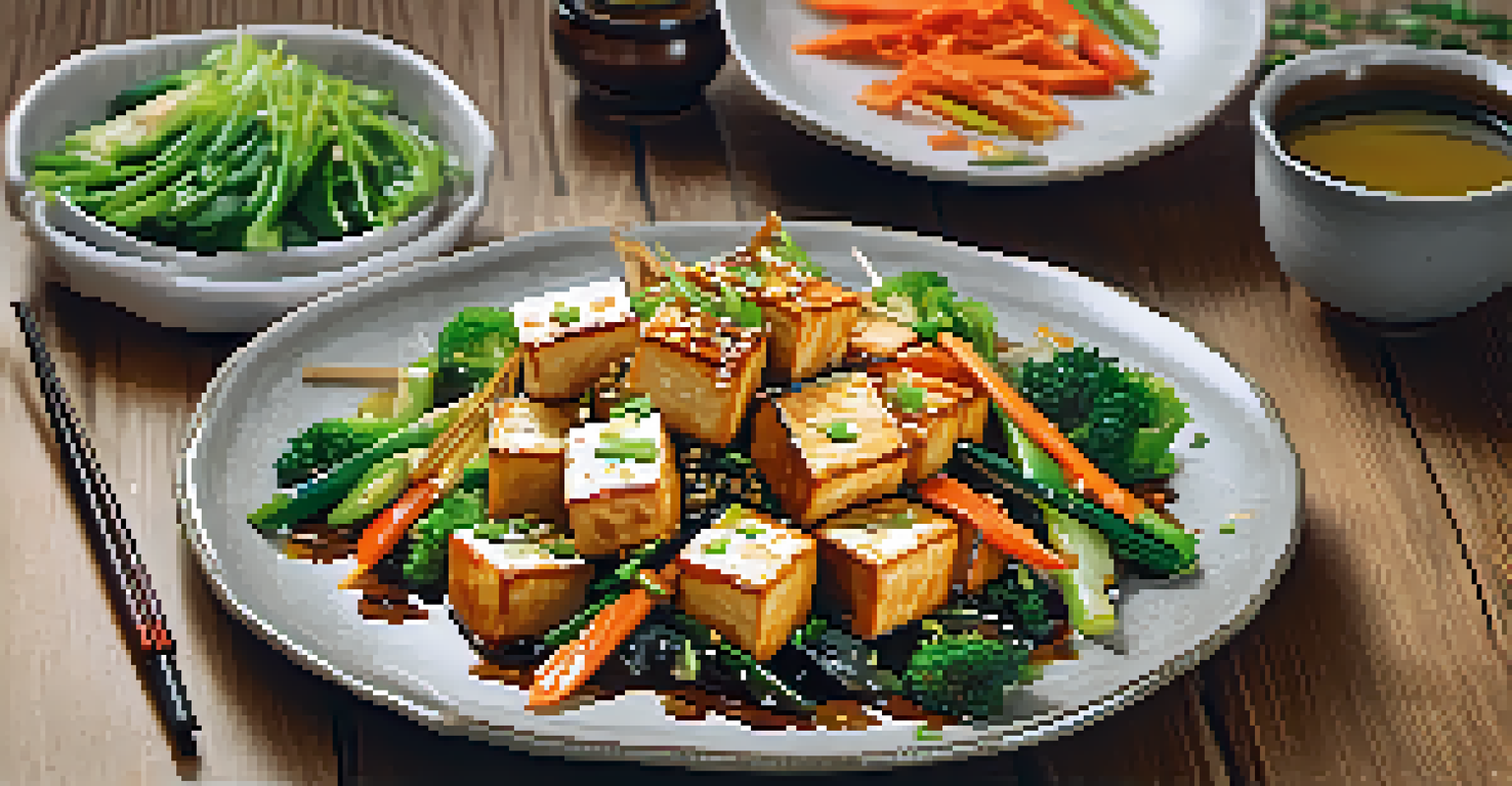Sesame Oil: A Flavorful Addition to Asian Vegetarian Cuisine

What is Sesame Oil and Its Varieties?
Sesame oil is a versatile oil derived from sesame seeds, commonly used in Asian cuisine. It comes in two main varieties: light and dark. Light sesame oil is made from raw seeds and has a mild flavor, while dark sesame oil is produced from toasted seeds, offering a richer, nuttier taste.
Cooking is like love. It should be entered into with abandon or not at all.
The unique characteristics of each type allow for different culinary applications. For instance, light sesame oil is great for frying and sautéing, while dark sesame oil is often drizzled over dishes as a finishing touch. Understanding these differences can elevate your cooking experience.
Both types of sesame oil are not only flavorful but also packed with health benefits, such as antioxidants and healthy fats. This makes them an excellent choice for those looking to enhance their diet while enjoying delicious flavors.
Health Benefits of Sesame Oil
In addition to its delightful flavor, sesame oil boasts numerous health benefits. Rich in vitamin E and healthy fats, it supports heart health and can help lower cholesterol levels. This makes it a fantastic option for those following a vegetarian diet.

Moreover, sesame oil contains lignans, which are compounds that may have anti-inflammatory properties. Regularly incorporating sesame oil into your meals can contribute to overall well-being, making it a smart choice for health-conscious individuals.
Sesame Oil Varieties Explained
Light and dark sesame oil each offer unique flavors and culinary uses, enhancing various dishes.
It's also worth noting that sesame oil can aid in skin health when used topically. Its moisturizing properties and ability to penetrate the skin make it a popular ingredient in natural skincare products.
How to Use Sesame Oil in Cooking
Using sesame oil in your cooking is simple and rewarding. A little goes a long way, so start with a small amount to avoid overwhelming your dish. You can use it for stir-frying vegetables, sautéing tofu, or even in salad dressings.
The secret of good cooking is, of course, good ingredients.
For a burst of flavor, consider adding a drizzle of dark sesame oil to your finished dishes. This oil can enhance the taste of soups, noodles, and grain bowls, creating a delightful umami experience. It's like adding a secret ingredient that transforms your meal.
Experimenting with sesame oil can lead to exciting culinary discoveries. Try mixing it with other oils or combining it with spices to create unique marinades or dipping sauces that elevate your vegetarian dishes.
Pairing Sesame Oil with Asian Ingredients
Sesame oil pairs wonderfully with a variety of Asian ingredients. Think soy sauce, ginger, garlic, and scallions—these flavors complement sesame oil beautifully. Together, they create a well-rounded flavor profile that enhances any vegetarian dish.
For example, a simple stir-fry with vegetables and tofu can be transformed by adding a splash of sesame oil along with some fresh ginger and garlic. The result is a fragrant and delicious dish that showcases the best of Asian vegetarian cuisine.
Health Benefits of Sesame Oil
Rich in vitamins and healthy fats, sesame oil supports heart health and skin wellness.
Don’t hesitate to mix sesame oil with citrus juices like lemon or lime for a refreshing twist. This combination can brighten up your dressings and marinades, making your meals even more vibrant and appetizing.
Incorporating Sesame Oil into Dressings and Marinades
Sesame oil is a fantastic addition to salad dressings and marinades. Its rich flavor can elevate a simple vinaigrette into something extraordinary. A blend of sesame oil, rice vinegar, and a touch of soy sauce can create a delicious dressing that enhances any salad.
For marinades, combine sesame oil with garlic, ginger, and a splash of soy sauce for a savory mixture. This marinade works wonders on vegetables, tofu, or even grains, infusing them with an irresistible flavor before cooking.
Getting creative with sesame oil in dressings and marinades can open up a new world of flavor. Don't shy away from experimenting—try adding honey or sesame seeds for an extra layer of texture and taste.
Flavor Profiles: Sweet and Savory Dishes with Sesame Oil
Sesame oil is not just for savory dishes; it can also add depth to sweet recipes. Think about incorporating it into desserts like Asian-inspired cookies or cakes, where its nutty flavor can enhance other ingredients beautifully.
For instance, a simple sesame oil and honey dressing can be drizzled over fresh fruit for a delightful dessert. This unexpected pairing can surprise your taste buds and impress your guests.
Creative Uses in Cooking
Sesame oil elevates both savory and sweet dishes, making it a versatile ingredient in the kitchen.
Balancing sweet and savory flavors is a hallmark of Asian cuisine, and sesame oil plays a key role in achieving that balance. Whether you're creating a savory stir-fry or a sweet treat, sesame oil can bring harmony to your dishes.
Conclusion: Embrace Sesame Oil in Your Cooking
Incorporating sesame oil into your Asian vegetarian cuisine is a journey worth embarking on. Its unique flavor and versatility make it an invaluable addition to your pantry. Whether used in cooking, dressings, or marinades, sesame oil can elevate your dishes in ways you might not expect.
As you explore the many uses of sesame oil, you'll find yourself creating vibrant meals that excite your palate. It's a small ingredient that can make a significant impact, transforming everyday dishes into culinary delights.

So, go ahead and embrace sesame oil in your cooking. With its rich flavors and health benefits, it's sure to become a staple in your kitchen, inspiring you to create delicious vegetarian meals.